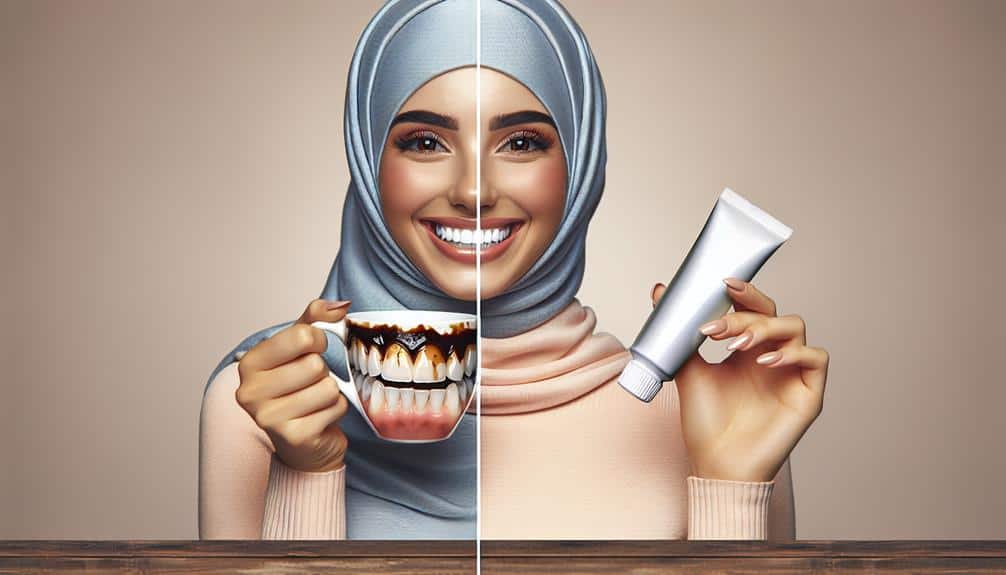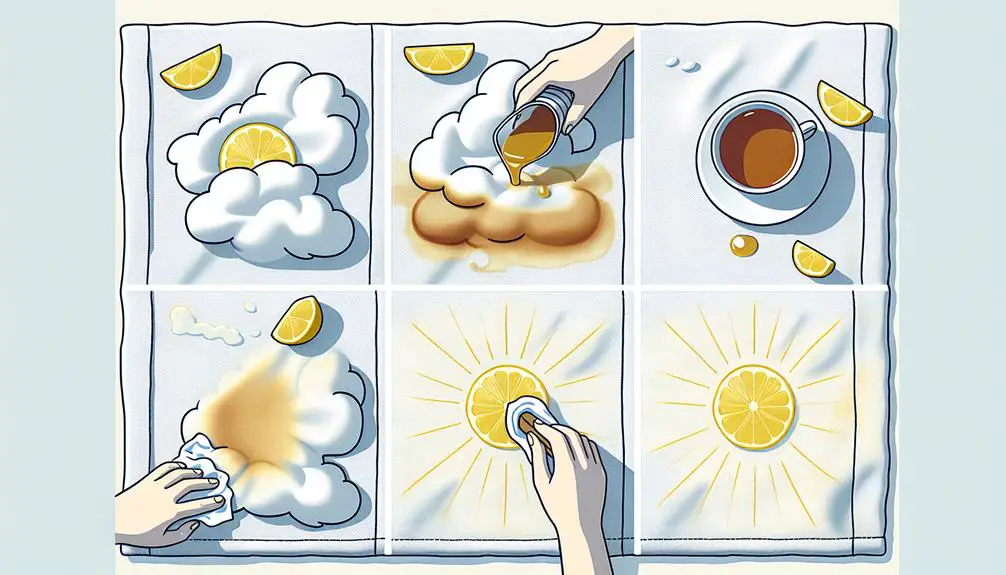For white teeth after tea stains, brush with baking soda to remove surface stains gently. Opt for a whitening toothpaste with hydrogen peroxide to brighten your smile effectively. Rinse your mouth with water after tea to prevent staining, and try oil pulling with coconut or sesame oil for added benefits. Make sure to visit your dentist regularly for professional cleaning and oral care advice. These tips can help you maintain a bright smile free from tea stains and improve your overall oral health. Mastering these strategies can enhance your teeth's whiteness and combat stubborn stains effectively.
Key Points
- Rinse mouth after tea to prevent stains
- Snack on crunchy fruits for natural abrasion
- Use whitening toothpaste with peroxide
- Regular oil pulling with coconut or sesame oil
- Visit dentist for professional cleaning and advice
Brush With Baking Soda
To effectively remove tea stains and whiten your teeth, consider brushing with baking soda. Baking soda, also known as sodium bicarbonate, offers multiple benefits for dental care. Its mild abrasiveness aids in removing surface stains caused by tea, coffee, or other pigmented foods. When used correctly, baking soda can help lighten the discoloration caused by these stains, revealing a brighter smile.
The benefits of using baking soda for teeth whitening are supported by research. A study published in the Journal of Clinical Dentistry found that toothpaste containing baking soda was notably more effective at removing stains and whitening teeth compared to toothpaste without it. This is due to baking soda's ability to break down the molecules that cause discoloration, resulting in a visibly whiter appearance.
When using baking soda for teeth whitening, it's important to do so in moderation to avoid damaging the enamel. Limit brushing with baking soda to a few times a week and always follow up with regular fluoride toothpaste to protect your teeth.
Use Whitening Toothpaste
Using a whitening toothpaste can help maintain the brightness of your teeth and combat stains caused by tea consumption. When selecting a whitening toothpaste, look for ingredients like hydrogen peroxide or carbamide peroxide, which are effective in removing surface stains.
Here are some tips for using whitening toothpaste effectively:
- Consistency is Key: Use the whitening toothpaste consistently, at least twice a day, for best results.
- Proper Brushing Technique: Make sure you brush your teeth thoroughly for at least two minutes to allow the whitening agents to work effectively.
- Avoid Abrasive Toothpaste: While whitening toothpaste can be effective, be cautious of abrasive formulas that may damage enamel over time.
- Combine with Professional Whitening Treatments: For more stubborn stains, consider combining the use of whitening toothpaste with professional dental care for thorough results.
Rinse With Water After Tea
After consuming tea, it's advisable to rinse your mouth with water to help prevent staining and maintain the whiteness of your teeth. Tea contains tannins that can lead to discoloration over time. By rinsing with water immediately after drinking tea, you can help wash away these tannins before they've a chance to adhere to your teeth. This simple practice is a proactive step in tea stain prevention.
In addition to rinsing with water, incorporating natural remedies like consuming crunchy fruits and vegetables can also aid in cleaning your teeth and reducing stains caused by tea. Foods like apples, carrots, and celery act as natural abrasives, helping to scrub away surface stains. Chewing sugar-free gum can also stimulate saliva production, which naturally cleanses the mouth and helps neutralize acids that contribute to staining.
Try Oil Pulling
Consider incorporating oil pulling into your oral care routine as a natural method to help maintain white teeth and reduce tea stains. Oil pulling involves swishing a tablespoon of oil in your mouth for about 15-20 minutes, which helps improve oral hygiene by reducing bacteria and plaque buildup.
Here are some key points to keep in mind when considering oil pulling to enhance your oral health:
- Choose the Right Oil: Opt for high-quality oils like coconut oil or sesame oil, known for their antimicrobial properties that can help combat bacteria in the mouth.
- Timing Matters: Oil pulling is most effective when done in the morning on an empty stomach before brushing your teeth to remove toxins and bacteria that have accumulated overnight.
- Be Consistent: To see real benefits, make oil pulling a regular part of your oral care routine. Consistency is key to improving oral hygiene and reducing tea stains over time.
- Do Not Swallow the Oil: After swishing the oil in your mouth, spit it out into a trash can to avoid clogging your sink and make sure you don't ingest the bacteria-laden oil.
Visit Your Dentist Periodically
Regular dental check-ups are crucial for maintaining peak oral health and preventing tea stains on your teeth. Visiting your dentist periodically not only guarantees that your teeth are professionally cleaned but also allows for preventive care measures to be taken. During these appointments, your dentist can remove any built-up plaque or tartar that may contribute to tea stains. Regular cleanings help prevent the accumulation of stains, keeping your teeth whiter and brighter.
In addition to cleanings, your dentist can also provide valuable advice on how to maintain a healthy smile and prevent tea stains. They may recommend specific oral hygiene practices or products tailored to your needs. Furthermore, dentists can detect early signs of staining or other dental issues, allowing for timely intervention.
Frequently Asked Questions
Can Using Lemon Juice Help to Remove Tea Stains From Teeth?
Using lemon juice to remove tea stains from teeth is a common remedy. The effectiveness is due to the citrus acid's impact on breaking down the stains. However, be cautious as excessive use may erode tooth enamel.
How Long Does It Take to See Results When Using Whitening Toothpaste for Tea Stains?
For tea stains, using whitening toothpaste typically takes a few weeks before you notice results. Whitening strips can show effectiveness in a matter of days. Professional treatments offer quicker outcomes, with visible improvements after just one session.
Are There Any Natural Remedies That Can Help Prevent Tea Stains on Teeth?
Looking to prevent tea stains on your teeth? Incorporate herbal remedies like green tea or chamomile for their effectiveness. Adjust dietary habits by reducing sugar intake. These simple adjustments can help maintain a brighter smile.
Can Drinking Tea Through a Straw Help Reduce the Risk of Staining Teeth?
Drinking tea through a straw can benefit your teeth by reducing the direct contact of tea with your enamel, thereby aiding in tea stain prevention. This simple habit can help maintain a brighter smile.
Is It Safe to Use Hydrogen Peroxide as a Teeth Whitening Solution for Tea Stains?
Using hydrogen peroxide for whitening tea-stained teeth is safe but should be done cautiously. Incorporate baking soda or charcoal powder for added effectiveness. Seek advice from a dentist before trying this method to guarantee safety.



